Related Research Articles

A knife is a tool or weapon with a cutting edge or blade, often attached to a handle or hilt. One of the earliest tools used by humanity, knives appeared at least 2.5 million years ago, as evidenced by the Oldowan tools. Originally made of wood, bone, and stone, over the centuries, in step with improvements in both metallurgy and manufacturing, knife blades have been made from copper, bronze, iron, steel, ceramic, and titanium. Most modern knives have either fixed or folding blades; blade patterns and styles vary by maker and country of origin.

A fishing rod is a long, flexible rod used by fishermen to catch fish. At its simplest, a fishing rod is a simple stick or pole attached to a line ending in a hook. The length of the rod can vary between 2 and 50 feet. To entice fish, bait or lures are impaled on one or more hooks attached to the line. The line is generally stored on a reel which reduces tangles and assists in landing a fish.
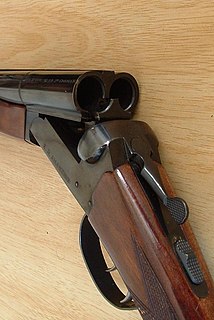
In firearms terminology, an action is the functional mechanism of a breech-loading firearm that handles the ammunition cartridges, or the method by which that mechanism works. Actions are technically not present on muzzleloaders, as all those are single-shot firearms with a closed off breech with the powder and projectile manually loaded from the muzzle. Instead, the muzzleloader ignition mechanism is referred to as the lock.

The discipline of origami or paper folding has received a considerable amount of mathematical study. Fields of interest include a given paper model's flat-foldability, and the use of paper folds to solve up-to cubic mathematical equations.
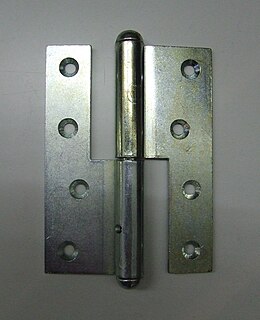
A hinge is a mechanical bearing that connects two solid objects, typically allowing only a limited angle of rotation between them. Two objects connected by an ideal hinge rotate relative to each other about a fixed axis of rotation: all other translations or rotations being prevented, and thus a hinge has one degree of freedom. Hinges may be made of flexible material or of moving components. In biology, many joints function as hinges like the elbow joint.
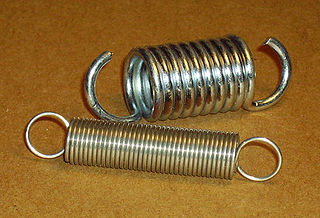
A spring is an elastic object that stores mechanical energy. Springs are typically made of spring steel. There are many spring designs. In everyday use, the term often refers to coil springs.

A dragon curve is any member of a family of self-similar fractal curves, which can be approximated by recursive methods such as Lindenmayer systems. The dragon curve is probably most commonly thought of as the shape that is generated from repeatedly folding a strip of paper in half, although there are other curves that are called dragon curves that are generated differently.

A truss is an assembly of beams or other elements that creates a rigid structure.

In structural geology, a fold is a stack of originally planar surfaces, such as sedimentary strata, that are bent or curved during permanent deformation. Folds in rocks vary in size from microscopic crinkles to mountain-sized folds. They occur as single isolated folds or in periodic sets. Synsedimentary folds are those formed during sedimentary deposition.
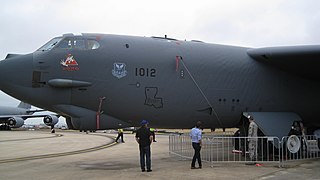
In structural engineering, buckling is the sudden change in shape (deformation) of a structural component under load, such as the bowing of a column under compression or the wrinkling of a plate under shear. If a structure is subjected to a gradually increasing load, when the load reaches a critical level, a member may suddenly change shape and the structure and component is said to have buckled. Euler's critical load and Johnson's parabolic formula are used to determine the buckling stress in slender columns.
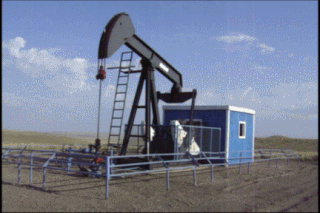
A four-bar linkage, also called a four-bar, is the simplest movable closed-chain linkage. It consists of four bodies, called bars or links, connected in a loop by four joints. Generally, the joints are configured so the links move in parallel planes, and the assembly is called a planar four-bar linkage. Spherical and spatial four-bar linkages also exist and are used in practice.
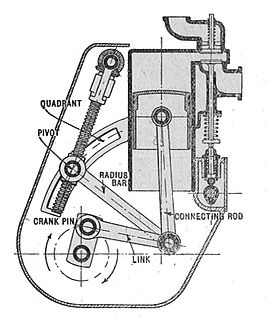
A mechanical linkage is an assembly of systems connected to manage forces and movement. The movement of a body, or link, is studied using geometry so the link is considered to be rigid. The connections between links are modeled as providing ideal movement, pure rotation or sliding for example, and are called joints. A linkage modeled as a network of rigid links and ideal joints is called a kinematic chain.

The Saiga-12 is a shotgun available in a wide range of configurations, patterned after the Kalashnikov series of rifles and named after the Saiga antelope. Like the Kalashnikov rifle variants, it is a rotating bolt, gas-operated gun that feeds from a box magazine. All Saiga-12 configurations are recognizable as Kalashnikov-pattern guns by the large lever-safety on the right side of the receiver, the optic mounting rail on the left side of the receiver and the large top-mounted dust cover held in place by the rear of the recoil spring assembly.

Plastic bending is a nonlinear behavior particular to members made of ductile materials that frequently achieve much greater ultimate bending strength than indicated by a linear elastic bending analysis. In both the plastic and elastic bending analyses of a straight beam, it is assumed that the strain distribution is linear about the neutral axis. In an elastic analysis this assumption leads to a linear stress distribution but in a plastic analysis the resulting stress distribution is nonlinear and is dependent on the beam’s material.

Chevron folds are a structural feature characterized by repeated well behaved folded beds with straight limbs and sharp hinges. Well developed, these folds develop repeated set of v-shaped beds. They develop in response to regional or local compressive stress. Inter-limb angles are generally 60 degrees or less. Chevron folding preferentially occurs when the bedding regularly alternates between contrasting competences. Turbidites, characterized by alternating high-competence sandstones and low-competence shales, provide the typical geological setting for chevron folds to occurs.
Decambering is the metalworking process of removing camber, or horizontal bend, from strip shaped materials. The material may be finite length sections or continuous coils. Decambering resembles flattening or levelling processes, but deforms the material edge instead of the face of the strip.
A bottom hole assembly (BHA) is a component of a drilling rig. It is the lowest part of the drill string, extending from the bit to the drill pipe. The assembly can consist of drill collars, subs such as stabilisers, reamers, shocks, hole-openers, and the bit sub and bit.

A deployable structure is a structure that can change shape so as to significantly change its size.

Metal expansion joints are compensating elements for thermal expansion and relative movement in pipelines, containers and machines. They consist of one or more metal bellows, connectors at both ends, and tie rods that depend on the application. They are differentiated according to the three basic types of movement: axial, angular and lateral expansion joints. Expansion joints have usage in various sectors, like energy productions, paper industry, chemical industry, water treatment, oil and gas. Everywhere where exist pipelines and occurs thermal movements or vibration, then expansion joints can be used.
High Strain Composite Structures are a class of composite material structures designed to perform in a high deformation setting. High strain composite structures transition from one shape to another upon the application of external forces. A single HSC Structure component is designed to transition between at least two, but often more, dramatically different shapes. At least one of the shapes is designed to function as a structure which can support external loads.
References
- ↑ USA1 20010037538,Duperray, Bernard; Alain Donzier& Jacques Sicre,"Automotive, self-locking and damping articulated joint and articulation equipped with the same",published 1999-16-07,issued 2001-11-08
- 1 2 Pellerin, André; Mazoyer, Thierry; Givois, Damien; Sicre, Jaques; Begoc, Gilbert, Antenna deployments: a self motorised hinge (PDF)